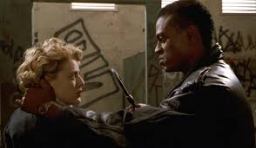‘Candyman’: More racism in ‘hood?
Black Slasher “Candyman” Draws Fire Over “racist” Depictions
By Glenn Lovell,
Chicago Tribune
Slick supernatural chiller or more thinly veiled racism from Hollywood? An unusually ambitious slasher entry that just happens to be set in a grim Chicago housing project, or an outrageous perpetuation of the worst myths and stereotypes affixed to the inner city?
These are some of the questions being asked by film-goers and filmmakers about “Candyman,” which details the mutilation murders of the title character , a hook-handed demon who preys on project dwellers while pursuing his one true love, a white university student (Virginia Madsen) researching a thesis on an urban legend.
, a hook-handed demon who preys on project dwellers while pursuing his one true love, a white university student (Virginia Madsen) researching a thesis on an urban legend.
At least two black filmmakers are cringing for other reasons. Reginald Hudlin, of “Boomerang” fame, calls such films “worrisome.” Carl Franklin, the man behind “One False Move,” is more direct. “It’s irresponsible and racist,” he charges.
Why the concern over what TriStar is pushing as “a modern Gothic horror”? The story is an Americanized version of cult novelist-filmmaker Clive Barker`s short story “The Forbidden,” set in the slums of Liverpool. Barker was executive producer on the film; fellow Brit Bernard Rose directed and wrote the screenplay, which, it can be argued, hinges on several racist myths.
Among these:
√ The bogyman (played by 6-foot-5 Tony Todd) is hulking, bloodthirsty and black.
√ The black community — here represented by Chicago`s Cabrini-Green apartment complex — is particularly susceptible to superstition and urban myth.
√ The projects are a ready-made house of horrors, guarded by gang members and overrun by crack addicts. (TriStar`s press kit for the movie described Cabrini-Green as “a hopeless community . . . a ghetto filled with poverty, despair and violence.”)
√ The black man`s anger toward the white Establishment is usually vented on his own race. (Though tortured and killed by a white mob in 1819, Candyman preys mostly on black women and children, whom he guts and mutilates with his hook.)
√ Black men, like the mournful Candyman, are obsessed with white women.
√ The black community is made up not of individuals but of amorphous faces that exact in-kind revenge or pay tribute en masse (like the ch orus in 1943`s “Cabin in the Sky”).
orus in 1943`s “Cabin in the Sky”).
“There`s no question that this film plays on white middle-class fears of black people,” Franklin says. “It unabashedly uses racial stereotypes and destructive myths to create shock. I found it hokey and unsettling. It didn`t work for me because I don`t share those fears, buy into those myths.”
Franklin said he was particularly offended by Candyman`s obsession with the stock Hollywood lady-in-distress, who`s sexy, tough and white. “It smacked of `King Kong.` Remember, Kong had all those black island women for the taking but he gave his life for a blond one, which is what Candyman does. Black women are again a nonentity in this film.”
As for Candyman`s exacting revenge through violence against his own community, this, too, “strongly reinforces white perceptions“ of blacks pitted against blacks. “I was particularly offended by the castration of a young black man. If that had been a Jewish person and he was shown being killed in a gas chamber, they (the Jewish community) would justifiably have been (angry).”
Hudlin said he had “trouble“ with the movie but, out of professional courtesy, wouldn`t go on record with specific complaints. “I`ve gotten calls about it (the movie), but I think I`m going to reserve comment. Some of my friends are in it and I may someday want to work for TriStar.
“Whatever`s going on in `Candyman` certainly isn`t new,“ he continued. “The first image recorded on film was of a black midget tap dancer, and `Birth of a Nation` (with its romanticized depiction of the Ku Klux Klan) is still being taught in film school.”
And how do the stars and director of “Candyman“ respond to such criticism? Defensively, to say the least.
“What`s wrong with Candyman craving a white woman? That`s not a stereotype. That`s real,“ said Madsen, previously seen in “The Hot Spot” and “Highlander II.“ “You know, the people who are most worried about this movie being racist are white. I find that amusing. To me this is a love story with a black phantom. The phantom is never allowed to be a black man.”
Still, Madsen conceded that she had initial concerns about the film`s racial subtext. “I was and am now worried about how people will respond,” she admitted. “I don`t think Spike Lee will like this film.”
British director Rose (“Paperhouse”) called himself an “outsider” who experienced “culture shock” while shooting in “still segregated” Chicago. “I think the film is confronting things,” he said. “It’s saying, ‘Why are you afraid of walking into this place?’ To feel that afraid is irrational.”
As for mounting criticism in the liberal community, that can only help ticket sales, he observed cynically. “I hope there is a hue and cry. I hope they try to paint us as racists. Our box office will go through the roof.”
Todd, formerly of “Platoon” and “Bird,” offered little more than a pained smile. He would neither support nor dismiss the anti-“Candyman” arguments. “I hear what you’re saying, man,” he nodded at the Toronto world premiere.
Knight-Ridder/Tribune
October 29, 1992
